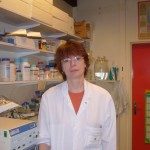Link to Pubmed [PMID] – 16154214
Mol. Biochem. Parasitol. 2005 Nov;144(1):55-67
Apical membrane antigen 1 (AMA1) is a membrane protein present in Plasmodium species and is probably common to all apicomplexan parasites. The recent crystal structure of the complete ectoplasmic region of AMA1 from Plasmodium vivax has shown that it comprises three structural domains and that the first two domains are based on the PAN folding motif. Here, we discuss the consequences of this analysis for the three-dimensional structure of AMA1 from other Plasmodium species and other apicomplexan parasites, and for the Plasmodium paralogue MAEBL. Many polar and apolar interactions observed in the PvAMA1 crystal structure are made by residues that are invariant or highly conserved throughout all Plasmodium orthologues; a subgroup of these residues is also present in other apicomplexan orthologues and in MAEBL. These interactions presumably play a key role in defining the protein fold. Previous studies have shown that the ectoplasmic region of AMA1 must be cleaved from the parasite surface for host-cell invasion to proceed. The cleavage site in the crystal structure is not readily accessible to proteases and we discuss possible consequences of this observation. The three-dimensional distribution of polymorphic sites in PfAMA1 shows that these are all on the surface and that their positions are significantly biased to one side of the ectoplasmic region. Of particular note, a flexible segment in domain II, comprising about 40 residues and devoid of polymorphism, carries an epitope recognized by an invasion-inhibitory monoclonal antibody and a T-cell epitope implicated in the human immune response to AMA1.
